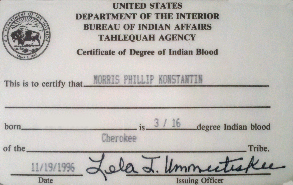Certificate of Degree of Indian Blood on:
[Wikipedia]
[Google]
[Amazon]
A Certificate of Degree of Indian Blood or Certificate of Degree of Alaska Native Blood (both abbreviated CDIB) is an official
''Bureau of Indian Affairs.'' 31 July 2011 (retrieved 6 Feb 2011) They are issued by the Bureau of Indian Affairs after the applicant supplies a completed"Sample Freedman Documents."
''African-Native American Genealogy.'' (retrieved 6 Feb 2011)

U.S.
The United States of America (U.S.A. or USA), commonly known as the United States (U.S. or US) or America, is a country primarily located in North America. It consists of 50 states, a federal district, five major unincorporated territori ...
document that certifies an individual possesses a specific fraction of Native American ancestry
In human population genetics, Native American ancestry refers to the theory that genetic ancestry can trace a relationship back to one or more individuals that were Indigenous to the Americas. However, there is no DNA test that can prove someon ...
of a federally recognized
This is a list of federally recognized tribes in the contiguous United States of America. There are also federally recognized Alaska Native tribes. , 574 Indian tribes were legally recognized by the Bureau of Indian Affairs (BIA) of the United ...
Indian tribe, band, nation, pueblo
In the Southwestern United States, Pueblo (capitalized) refers to the Native tribes of Puebloans having fixed-location communities with permanent buildings which also are called pueblos (lowercased). The Spanish explorers of northern New Spain ...
, village, or community."Certificate of Degree of Indian or Alaska Native Blood Instructions."''Bureau of Indian Affairs.'' 31 July 2011 (retrieved 6 Feb 2011) They are issued by the Bureau of Indian Affairs after the applicant supplies a completed
genealogy
Genealogy () is the study of families, family history, and the tracing of their lineages. Genealogists use oral interviews, historical records, genetic analysis, and other records to obtain information about a family and to demonstrate kin ...
with supporting legal documents such as birth certificates, showing their descent, through one or both birth parents, from an enrolled Indian or an Indian listed in a base roll such as the Dawes Rolls
The Dawes Rolls (or Final Rolls of Citizens and Freedmen of the Five Civilized Tribes, or Dawes Commission of Final Rolls) were created by the United States Dawes Commission. The commission was authorized by United States Congress in 1893 to exe ...
. Blood degree cannot be obtained through adoptive parents. The blood degree on previously issued CDIBs or on the base rolls in the filer's ancestry are used to determine the filer's blood degree (unless they challenge them as inaccurate). Information collected for the filing is held confidential by privacy laws, except if the CDIB is related to assigned duties.
A CDIB can show only the blood degree of one tribe or the total blood degree from all tribes in the filer's ancestry. Some tribes require a specific minimum degree of tribal ancestry for membership, which might require the first type of certificate, while some federal benefits programs require a minimum total Indian blood degree so an individual might require the second type of certificate to qualify. For example, the Eastern Band of Cherokee Indians
The Eastern Band of Cherokee Indians (EBCI), (Cherokee: ᏣᎳᎩᏱ ᏕᏣᏓᏂᎸᎩ, ''Tsalagiyi Detsadanilvgi'') is a federally recognized Indian Tribe based in Western North Carolina in the United States. They are descended from the smal ...
requires at least 1/16 degree of Eastern Cherokee blood for tribal membership, whereas the Bureau of Indian Affairs' Higher Education Grant for college expenses requires a 1/4 degree minimum.
A Certificate of Degree of Indian Blood does not establish membership in a tribe. Tribal membership is determined by tribal laws and may or may not require a CDIB or may require a separate tribal determination of ancestry or blood degree.
The CDIB is controversial, from a racial politics perspective, and because non-federally recognized tribes are neither eligible for the card nor for the benefits which require one. Some groups, such as the Cherokee freedmen, were often not eligible for a CDIB because they are not Native American by blood or their degree of blood was not recorded in the base rolls (where Freedman was used instead of stating a degree).''African-Native American Genealogy.'' (retrieved 6 Feb 2011)

See also
* Blood quantum laws *Lineage-bonded society
A lineage-bonded society is a type of acephalous society predicated on claims of a common ancestor.
A lineage-bonded society is by population, the smallest classification of acephalous society. Beyond a certain size threshold, claims of common l ...
*Pedigree chart
A pedigree chart is a diagram that shows the occurrence and appearance of phenotypes of a particular gene or organism and its ancestors from one generation to the next, most commonly humans, show dogs, and race horses.
Definition
The word pedigre ...
* Judicial aspects of race in the United States
References
{{DEFAULTSORT:Certificate Of Degree Of Indian Blood Native American history Native American law Identity documents of the United States Genealogy